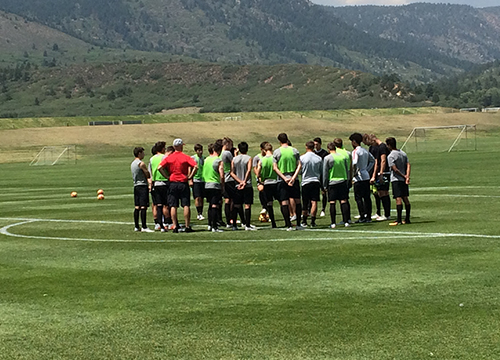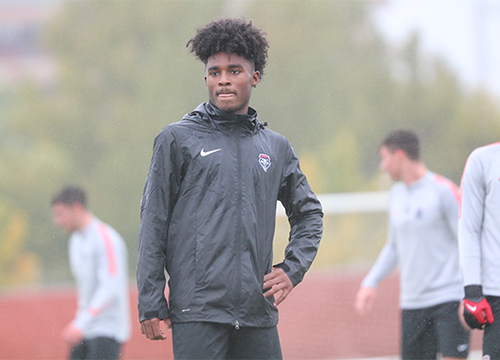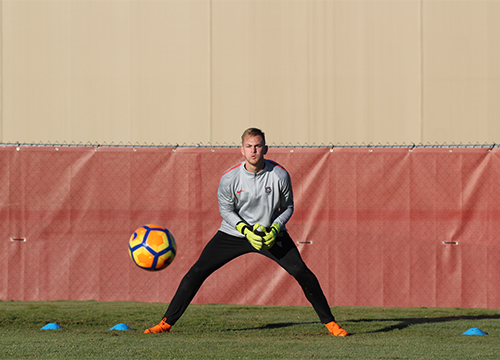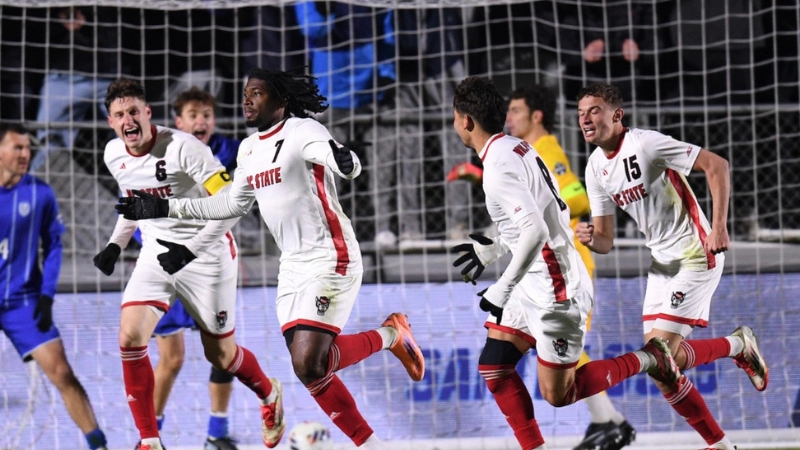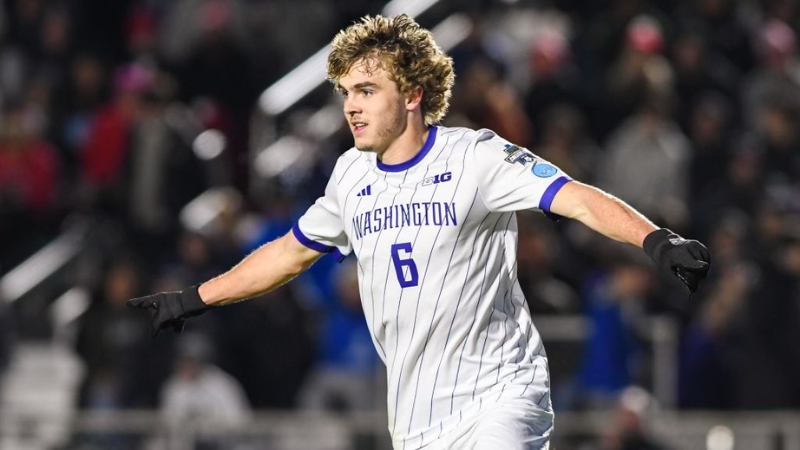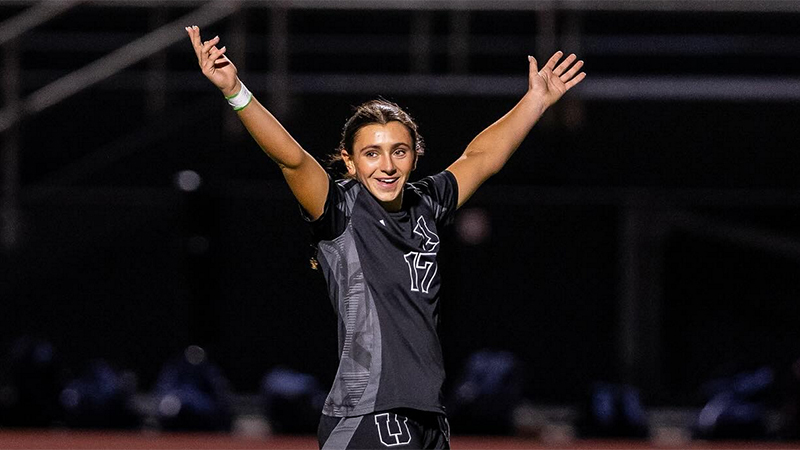New Mexico's final season: The Decision
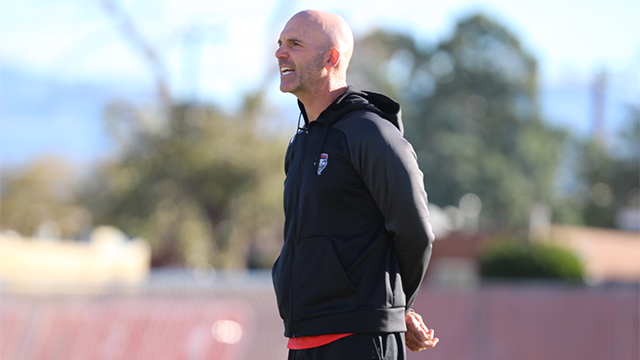
Less than a month before the start of last year’s college season, the University of New Mexico announced that, due to ongoing budget deficits and Title IX concerns, the 2018 season would be the final one for its nationally prominent men’s soccer program. This decision to cut soccer created a maelstrom of debate and controversy. The state’s politicians (among others) got involved. But for the Lobos players and coaches, there was still a season to play. This series is an insider’s deep dive into that final season, and the story of a team fighting for a proper ending.
***
1. The Decision
Fish is doubled over at midfield—hands on knees, shoulders hunched. His gaze is fixed on the perfectly manicured grass (this is the United States Air Force Academy after all) at his feet. The New Mexico players flutter back and forth across the pitch as their coach tries to catch his breath on this warm August afternoon.
Partly it’s physical pain. In his quest to get back into fighting shape (“I was fat last season”), Jeremy Fishbein recently took a nasty spill on his mountain bike, resulting in bruised ribs and scraped hands and forearms. He’s still healing.
But mostly it’s the prospect of losing his program—one that he built over the past two decades—that has literally stopped the bald-headed, old-school coach in his tracks.
“I’m angry,” Fish says. He slowly stands back up. Then his attention flips back to the task at hand. “Stop [expletive] complaining. Let’s go!” he barks as the guys switch drills. He’s stewing, wandering around at his own team’s soccer practice but only keeping one eye on the action on the field.
He turns to me: “You hear anything? I’m pretty distracted … I don’t know what the next steps would be…” He trails off.
Wait, does he want me to check my phone?
There are many mantras in the world of Lobos soccer.
“Work your nuts off.”
“Don’t let yourself off the hook.”
“Control the controllables.”
There’s also this one: STAY OFF YOUR PHONES! In order to encourage engagement at team events—meals, meetings, practices, and in the locker room—Fish believes that phones should never be seen near a soccer field. Never. He holds himself to the same standard, even on a day like this one, a day when he’s obviously distracted and when he badly wants to check in with what’s going on beyond the pitch.
The big distraction?
As the Lobos practice at Air Force, a political fight over the program’s survival is playing out. 393 miles south—back down the I-25 at the Lobos home campus in Albuquerque, New Mexico—the UNM Board of Regents has convened a meeting with one agenda item: to cut the Men’s Soccer program (and 4 other teams) at the university. Again.
(The Lobos practice at USAFA as the UNM Board of Regents vote to cut the program)
***
Jeremy Fishbein, 53, took over as the head coach of the Men’s Soccer Program at the University of New Mexico in 2002. He was a first-year assistant at the school at the time. “I was out recruiting in Arkansas,” Fish remembers. “I got a call from one of the Athletic Directors that Klaus [Weber] had resigned…kind of out of the blue.” Fish took over in Albuquerque and never looked back.
Fishbein grew up in Cincinnati, Ohio. A multi-sport athlete who exceled in baseball and basketball, Fishbein earned All-Conference honors as a midfielder playing soccer for Walnut Hills High School. “I was a tough athlete who liked to compete,” Fish says of his playing days. “I wouldn’t say I was a great technician.”
He played physically and all out. He didn’t necessarily need the ball to do his best work. Or as one of his assistant coaches put it: “Fish was a bruiser.”
Fishbein earned a college scholarship just as NCAA Division I schools were adding men’s soccer programs by the dozens. After considering several schools, Fish signed with the University of Richmond. It was a mistake. His parents wanted a great academic school (Fishbein’s father, Harold Fishbein, was a renowned Professor of Psychology at the University of Cincinnati), but the culture shock was too much. “Not the place for me,” he says. “I probably didn’t realize how Southern it was…and I probably screwed around too much.”
Fishbein eventually transferred back to Cincinnati, and then to UC Santa Barbara. “In retrospect, it was a disappointing college experience,” he says of his time in the trying climes of Santa Barbara, “but I learned a lot about the coach I wanted to be.”
After short stints in professional soccer (in Australia, New Zealand, and California), Fishbein began his coaching career at Fort Lewis College in Durango, Colorado. The college had just begun its Division II men’s program and needed someone with the energy and drive to get things cranked up. And someone willing to live in Durango. Fishbein fit the bill.
In short order, Fishbein built a nationally relevant program in remote southern Colorado.
“They had very little resources and the expectations weren’t very high,” Jeremy Gunn, who succeeded Fishbein (before going on to win three national championships at Stanford), says, “He brought Fort Lewis national recognition. He basically started everything.”
Along the way, Fishbein spent two summers in Albuquerque, at UNM, working on a Master’s degree in Sports Administration. There Fishbein met a UNM tennis player—Alicia Meraz. Alicia, on her way to a professional tennis career and two graduate degrees from UNM, and Fish married shortly thereafter. They now have two teenage daughters.
When Fish took over the New Mexico program, he “basically cleaned house,” remembers one of his first recruits. New players and coaches flooded in; those from the previous regime mostly left. Any acceptance of complacency was squashed.
“We wanted somebody with a lot of fire and passion,” said Rudy Davalos, the UNM Athletic Director at the time. “[Fishbein] was extremely confident in himself and he was a hard worker. We knew he would be successful if given the proper support.”
Successful indeed.
Year 1 (2002): 18-4
Year 2: 8-9-3 (playing a more national schedule for the first time)
Year 3: 17-1-2
Year 4: 18-2-3
Built on the backs of New Mexico kids—especially those from the Albuquerque Bandidos club—the Lobos became a thing in Albuquerque. Year four (2005) of the Fishbein reign culminated with the Lobos advancing to the NCAA College Cup and then the Division I tournament final. The Lobos fell 1-0 to Sasho Ciroski‘s University of Maryland squad.
The winning continued from there. Under Fish, the Lobos won 70% of their games, qualified for the NCAA tournament 12 times, and returned to the College Cup in 2013. The Lobos also led the nation in attendance and raised $50,000 for Pat Grange’s heartbreaking fight against ALS. The program has had 20 players selected in the MLS draft. Academically, the Lobos were perhaps even more dominant, earning 15 NSCAA Team Academic Awards and producing 22 Academic All-Americans under Fishbein’s leadership—more than any other NCAA team during that period.
But none of that could offset the budgetary typhoon that had descended upon Lobo Athletics by 2018. Year after year of deficits, report after report detailing red ink. Something had to change.
***
Since rumors about cutting the Lobo soccer program began in April, the roster for the 2018 season came together haltingly.
Three Lobos with remaining eligibility bolted to sign professional contracts. Most prominently, Aaron Herrara, a Las Cruces native, inked a homegrown contract with Real Salt Lake. Herrera led the Lobos in scoring in 2017.
Six other members of the 2017 Lobos—also with remaining eligibility—decided to transfer to other schools. Three graduated.
Player movement from one university to another is more rampant in college soccer than any other sport. According to the NCAA, 18.1 percent of the average Division I soccer roster is made up of players who competed at another university first. Unlike college baseball, basketball, football, and hockey players, college soccer players have the blessing of the NCAA to transfer and play immediately.
On average, the Lobos turn over about a third of their roster each year. In 2018, the tumult is much more significant. The Lobos for the first time in recent memory will have fewer returning players than new ones.
Thus the Lobos have an abundance of freshman. Everywhere you look, there are freshmen doing, well, freshmen things. On gear day, upon being instructed to write his name in his team issued Nike stuff, one of the freshman does so with gusto. Now his name shows through the back of his shirts.
The 14 newcomers can be separated into four basic groups: United States Soccer Development Academy (USSDA) recruits, Albuquerque recruits, transfers, and foreign recruits.
The USSDA guys arrive in Albuquerque from all over the United States. They’re guys like Omar Grey. Born in Jamaica, Omar looks taller than his 6’0 due to his Mohawk afro. Omar developed his game with the Crossfire FC in Seattle, Washington, and, unlike many of his generation, refused to specialize too early. He lettered in basketball, football, and soccer in high school. “Best athlete on the team … a borderline DI basketball player,” says Fish one day at practice.
Talented, hardworking, and charming, Omar has just one thing working against him: he has a hard time showing up on time—for practices, for meetings, and for class.
(Omar Grey, Lobo Freshman)
The four Albuquerque recruits (Anthony, Carlos, Julian, and Nick Williams) know the city and university well. They grew up attending Lobos games and camps.
Nick Williams (who like Christopher Robin always seems to be called by his first and last names) comes to the Lobos squad from Albuquerque Academy, the city’s most elite and expensive private school. His father, Greg Williams, is the lawyer taking the lead in challenging the Board of Regents decision. Nick Williams is a powerful, compact, confident player.
The one transfer who sticks for the 2018 season (several arrive and then make quick departures without ever playing a game for the Lobos) is Matt Puig. Puig comes to New Mexico from Tulsa University, where in 2016 as a freshman he started 15 games, led the team in scoring, and earned second-team All-Conference. After sitting out the 2017 season, Matt comes to New Mexico looking for a fresh start and, always, to score some goals.
Lastly of the newcomers, there’s Maliek Howell. A 6-foot-1 defender from Kingston, Jamaica. Maliek is as decorated a recruit as Fishbein has ever landed. He has played with the U17 and U20 Jamaican Team. Unfortunately for all involved, Maliek is forced to sit out the 2018 season when his credits don’t match up to the NCAA’s requirements. He’s marooned in ABQ for the fall, with no outlet for his considerable soccer skill set.
These 14 newcomers join 13 returning players.
The returnees include mostly DA products as well. 5th year senior Matt Dorsey (Houston Dynamo) leads the veterans. Nick Barreiro (Real Salt Lake U18), Grayson Dupont (Birmingham, AL), Bailey Leatherman (Seattle Crossfire Premier), and Nick Taylor (Dallas Texans Red U99), all expect to play major minutes.
There is also a tight-knit international contingent among the returnees: Simon Spangenberg (Belgium), Antoine Vial (France), Tom Smart (Northern Ireland), Aaron “Scotty” Scott (Scotland), and Billy Jones (New Zealand).
Certainly though it’s the locals—Ford, Mikey, and Shamach—among the returnees with the most to lose. And particularly Ford Parker.
(Ford Parker: Albuquerque native, goalkeeper)
Ford Parker is the redshirt junior goalkeeper who has been waiting his turn. A product of Albuquerque’s Sandia High School, Ford has targeted 2018 as his year. Jason Bealieau, the goalie who is now with the Montreal Impact, has finally—after four years as a starter—vacated the spot between the pipes.
***
At the front of the large ballroom sits the Board of Regents and the university’s most senior administrators. At a few minutes before 1 p.m., President Garnett Stokes enters the room, greeting and chatting as she makes her way to the center of a u-shaped table, to the center of a maelstrom that began gathering forces years and years before she arrived.
Stokes has a whole host of other things to do for her new university. She’s been on the job for less than six months. But athletics tend to draw more public interest than issues surrounding the university’s new hospital project or institution’s declining enrollment. As Stokes says with a wry smile, “Athletics is always going to get more scrutiny than, say, the budget for the history department.”
Stokes knows the burdens of Division I athletics and their accompanying scandals. During her time as the Interim President at Florida State University, Stokes had to deal with Jamies Winston.
“If we hadn’t won the Clemson game once Jameis Winston was suspended, I would have needed police protection,” Stokes recalls of the 2014 controversy.
As chancellor at the University of Missouri, she navigated the tumult following the Ferguson riots, when the school’s football team threatened to quit if the racial climate was not addressed.
So Stokes knows about the power of football, but none of her previous institutions—Georgia, Florida State, or Missouri—even fielded a men’s soccer team.
Chairman of the Board of Regents, Rob Doughty calls the meeting to order at 1:05 p.m. He starts with the obvious: this is a do-over. The Board already made this decision, back on July 19. They are only doing it again because the state’s Attorney General determined that the proceedings violated New Mexico’s open meetings statute.
Nearly 400 people jam the ballroom. There are not enough chairs for everyone. Unlike the meeting in July, there is not the added energy from a hundred or so amped up, Lobo-soccer-shirt-wearing children. School is back in session in Albuquerque.
“Our student athletes are talented, dedicated young men and women, and their accomplishments are a point of pride,” Stokes begins, reading from prepared remarks. What’s more, she says, “athletic programs are vital to who we are as an institution and a community.”
Then it’s on to the problems.
The New Mexico Department of Higher Education, due in large part to the recurring issues in the athletic department, has placed UNM under its “enhanced financial oversight program.”
From this sobering reality, Stokes moves onto a point that she emphasizes repeatedly, perhaps because it is among the most simple, powerful arguments at her disposal: the university simply has too many teams. If the University of Texas, for example, with its behemoth $220 million budget, supports the NCAA minimum 16 athletic teams, why does UNM (athletics budget: $33 million) have 22?
Too many teams; not enough money.
Stokes’ argument wins over few, if any, in the crowd. No one’s really here to change sides. But if nothing else, Stokes conveys the real angst over (and commitment to) the decision she feels. It’s a “painful, painful process,” she says. “Obviously no one does this unless they think they absolutely have to,” she’ll say later.
After Stokes, the Athletic Director, Eddie Nunez, takes over. He’s been at New Mexico just a few months more than Stokes. He’s inherited an athletic department drowning in debt and pockmarked by scandal. Like the President, he came to UNM from an SEC school—Louisiana State University. There for fourteen years, Nunez helped build the Tigers program—literally, overseeing more than $400 million in construction improvements to LSU’s gleaming, sprawling athletic facilities complex. Now he’s in New Mexico. With a budget crisis. In front of an audience enraged over a soccer cut (LSU does not field a men’s soccer team either) and tasked with presenting—again—the case for downsizing.
Nunez articulates the three main criteria used to determine which teams got cut.
First, the athletics department needed to find real financial relief. The cuts only mattered if they put a significant dent in the recurring budget deficit of nearly $2 million.
Second, the changes had to bring the university into compliance with Title IX law.
Third, the Mountain West Conference. The University of New Mexico helped found the Mountain West Conference in 1999 (as a breakaway from the unwieldy Western Athletic Conference). The school has no desire to jeopardize its relationship with the conference now in 2018.
The men’s soccer team competes in Conference USA because the MWC does not offer the sport.
***
Fifty-three people have signed up to speak. Every single one is against the cuts. Grim faced, Doughty calls up the first speaker.
Patricia Lundstrom steps to the podium amid applause.
Lundstrom, the Chair of the State Appropriations Committee, puts her reading glass on the tip of her nose. The 60-year-old political brawler has served in the New Mexico Legislature (representing a district in Gallup) since 2001.
Lundstrom is among the handful of most powerful politicians in the state. She controls the committee that controls the state’s purse strings. And right now she’s a bit perturbed.
After starting with a few benign compliments, Lundstrom demands a stay of execution. “Today the Legislature is in a stronger position,” she says. The oil boom going on in southern New Mexico’s Permian Basin has changed the state’s situation considerably.
“While some policymakers have recently expressed the view that legislators should stay out of this decision,” she will say later, “that’s hogwash.” The state will find the money. For once, there is money to spend. Her applause line is this: “My request of you today is to slow down, postpone your decision, and work with me and the legislature to define a path to solve this problem.” With this, the audience erupts in applause.
Time!
Doughty cuts Lundstrom off, just as she is saying, “You know, Title IX is a good thing…”
“Thank you Representative, the time’s up. We’ve got to get through everybody today.”
Stunned, Lundstrom stares at the Board in disbelief. She is offering funding levels for athletics that the university has never seen. The crowd boos and taunts.
“Let her speak!
“This is stupid.”
“Oh come on.”
“She’s an official of the state. Let her speak!”
Several people shout out offers to give Lundstrom their allotted time. But the Board does not budge from its three minute per person standard. Slowly, maintaining eye contact with those sitting along the u-shaped table, Lundstrom gathers up her papers. She lets the moment hang and draw out. Then she backs away from the microphone.
Thus the embers of political war gain a powerful dose of oxygen.
After Lundstrom, four other Democrats take their three minutes to rail against the Board’s decision. Their criticisms range from a call to cut football and a complaint about why more in-state athletes are not on scholarship, to points about coaching salaries and the university’s proclivity for “golden parachutes.”
Rep. Moe Maestras closes with a cultural plea. Albuquerque is a soccer city. “Don’t cut soccer in a city where 65% of our first graders are Latino; it just doesn’t make sense,” he concludes.
The parade of speakers in favor of keeping UNM’s soccer program continues for more than four hours. “The team can’t be here. They’re in Colorado getting ready for a game,” says Tom Parker—Ford’s father. So others talk for them. Students. Alums. Economists. Lawyers. Coaches. They all have, basically, the same message: While we understand the budget challenges, please don’t do this.
Finally, the Board of Regents retakes control of the conversation. The group enters into a forced, awkward, faux-debate on the matter.
What had the university requested in the past from the Legislature? How important is the Mountain West Conference, really? Should the university just forgive the athletics department’s debt? How (and this one is always a favorite) many New Mexicans are on each of the discussed teams?
When the group lands back on Title IX, it becomes clear that the Board of Regents, does not really understand the intricacies of the law as they apply to college athletics. One regent begins reading from statute. “I’ve been reading and hearing in our meeting today…” He stops. “I wonder if someone could comment on the federal law.”
Can someone explain Title IX?
“Eddie?”
“I’m the wrong person, I can’t comment on the federal law,” the Athletic Director responds.
The Regents then ask if the Dean of the New Mexico Law School is in the room. Perhaps he could explain the issue. Alas, he is not.
Finally, at 5:25 p.m. Chairman Doughty calls for a vote. Soccer remains, along with skiing and beach volleyball, on the chopping block.
“I move to approve the administration’s proposal to eliminate those sports.”
“All those in favor say Aye?”
“Aye”
“All those opposed?”
Silence.
“It passes unanimously. 7-0.”
The crowds boos, but with a sense of resignation and fatigue. And with that, the Board adjourns. The action portion of the meeting takes less than a minute. It’s done. Again.
***
Fish, who made it back from practice at Air Force to his hotel room in time to watch the last two hours of the meeting on Facebook, is stunned at the result. “Speechless and numb,” he says minutes after the final vote.
Later that evening, the team gathers in a frigid conference room at the Baymont Inn and Suites to discuss the situation. Reactions to the news vary. For the New Mexico players especially, the loss of the program is devastating. For those Lobos with just one season left to play, it is disconcerting and confusing. For others, including the foreign guys, it simply means getting back onto the recruiting treadmill and looking for a new team.
“The distractions are only going to increase,” Fish warns the group. Then he sends everyone—two by two since that’s the rooming arrangement—off to bed.
The next day, at noon on Saturday, August 18, the Lobos play their final exhibition game. The Falcons are a tough, disciplined team; they qualified for the NCAA tournament in 2017.
“It’s a pretty sweet test for us,” Fish says to the team in the cramped locker room before the game. “Be excited. How good can you be?” And then a last minute reminder: “No cussing.”
As the two teams warm up, a cool breeze blows through the foothills. Air Force’s soccer stadium consists of a small press building with a set of bleachers on either side. If not for the mountains behind the facility, the place would not deserve a second glance. With them, it’s one of the most scenic college soccer venues in the country.
As the warm ups wind down though, clouds gather behind the mountains, at first providing welcomed shade, but then stirring concerns about hail and lighting—a constant issue in Colorado Springs in late summer.
Just minutes before game time, the Air Force coaches jog over to their New Mexico counterparts to confer. With a storm surely approaching, the Air Force officials want to move the game into the school’s massive indoor football facility. It’s a half mile away. After a bit of griping, the New Mexico players gather their stuff. The several dozen fans head for their cars. The New Mexico team piles back onto its chartered bus for the short drive across campus.
As it turns out, not even the US Air Force can really predict the weather. By the time everyone arrives at the new game venue, not more than ten minutes after the venue decision was made, the winds have blown the clouds away. The storm has disappeared.
Walking up the steps in the sunshine, Fish can’t help but call out the Air Force. “Army or Navy would have got this right,” he jabs in the direction of the Falcon’s coaches.
At halftime, the Air Force contingent come across the indoor field. “Let’s go back outside.” The weather is now perfection; sun shining, with a still-cool breeze blowing. Air Force wants to get back out on its natural grass surface.
After a bit of back and forth, again with some grumbling from his players, Fish gives in. Everybody piles back into their cars to return to the outdoor field for the second half. Several pickup trucks haul the Falcons up the hill, five or six in the back of each.
The second half plays out outside. With five minutes left in the second half, the Lobos finally find an equalizer. Bailey takes a penalty kick; Billy heads it in. 1-1. The game ends tied.
(Grayson Dupont watching the action during the UNM-USAFA exhibition)
While hardly an ideal exhibition trip, the coaches (Fish, Mike Graczyk, Kelly Altman, and Lucas “Champ” Champenois) are generally pleased. Two good teams (the Lobos tied 2-2 at Denver University two nights earlier); two good efforts. “We’re going to be pretty good,” Fish says on the field after the Air Force game.
But after a bizarre indoor-outdoor exhibition, and two Colorado ties, all while the program is being cut for a second time, who really knows.
Ryan Swanson is an Associate Professor at the University of New Mexico. He studies the role of sports in America, and is the author of the recently released The Strenuous Life: Theodore Roosevelt and the Making of the American Athlete.
Headlines
- Recruiting Roundup: December 8-14
- High School All-American Games Stream
- How Do I Get Scouted by TopDrawerSoccer?
- 2026 Women's Division I Transfer Tracker
- NC State Advances to First College Cup Final
- Washington Dominates College Cup Semifinal
-
GA Showcase/Champions Cup Goal Scorers

- TopDrawerSoccer TeamRank Update - Boys
-
High School All-American Game Preview

-
ECNL Girls New England Players to Know


